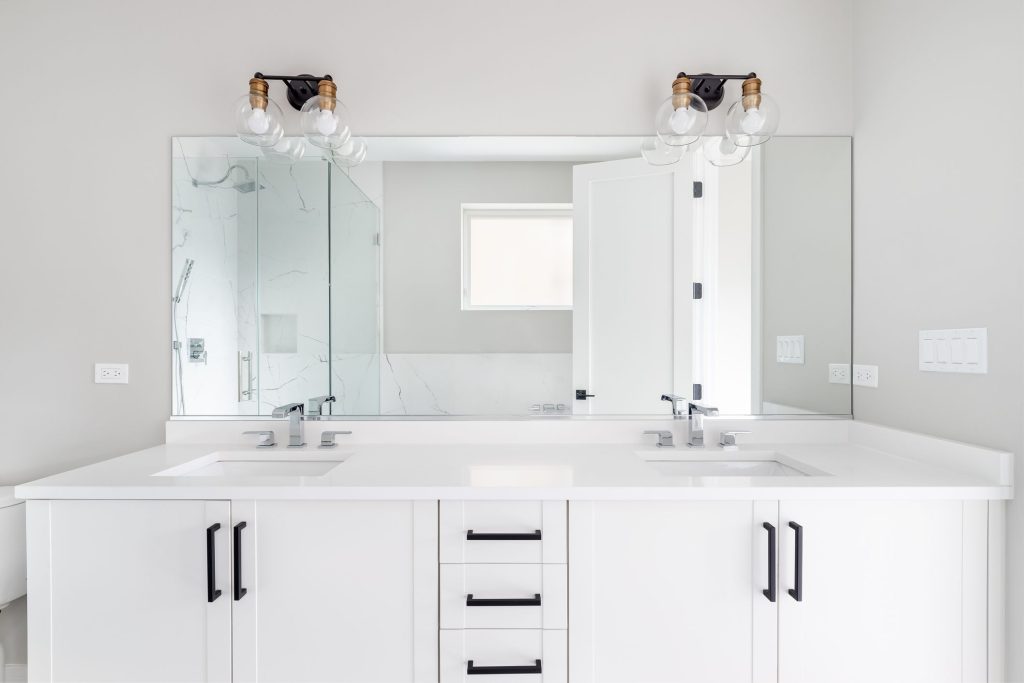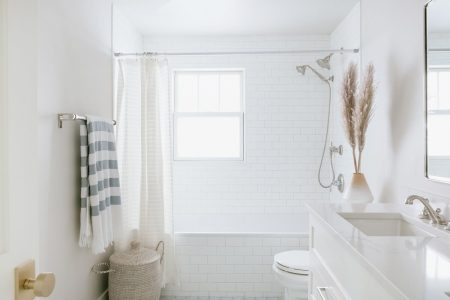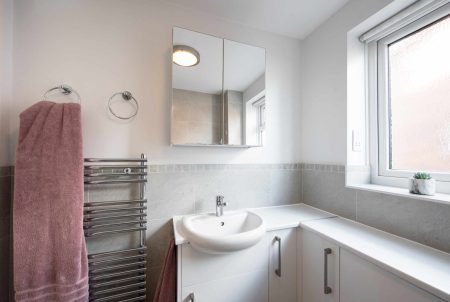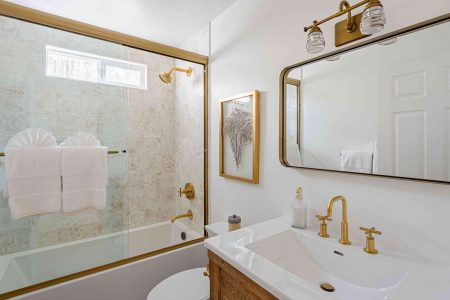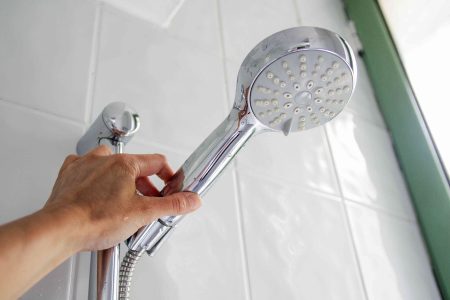Want to give your bathroom a makeover without renovating the whole thing? Painting a bathroom vanity is an easy way to make a huge difference to the look and feel of the space—no demo required.
While painting a bathroom vanity is a more straightforward DIY project than painting kitchen cabinets, it’s important to prepare for all aspects of painting, from sanding and priming to painting and reinstalling hardware. For best results, follow these steps and you’ll have a refreshed bathroom in less than a day.
Types of Paint for a Bathroom Vanity
There are many types and colors of paint to choose from. When choosing a paint for a bathroom vanity, you want one that is more effective at repelling moisture. For this reason, opt for semi-gloss or high-gloss paint, which will help protect the vanity from water damage.
What You’ll Need
Equipment / Tools
- Paint brush
- Small roller handle
- Small high-density foam roller
- Paint tray
- Cordless drill or screwdriver
- Clean bucket
- Cleaning sponge
- Rag
- Vacuum
- Drop cloth
Materials
- Semi-gloss or high-gloss paint
- Degreaser
- Primer
- 220-grit sandpaper
- Sanding sponge
- Painter’s tape
- Wood putty or wood filler
- Paint tray liners (optional)
- Hardware (if replacing)
Instructions
How to Paint a Bathroom Vanity
-
Empty the Bathroom Vanity and Remove Doors and Handles
Empty all items and toiletries stored in the bathroom vanity and drawers. Using a cordless drill or screwdriver, detach the handles, knobs, and hinges. If you plan to reuse the hardware, label them and store them in a plastic bag or container.
Remove the bathroom vanity doors and drawers, if they can be detached. Set them aside on a drop cloth to be painted separately from the cabinet base.
-
Clean the Surfaces You’re Painting
Using a degreaser, clean the surfaces of the bathroom vanity doors, drawers, and cabinet frame. After cleaning, wipe the surfaces down with water and a sponge or rag to remove any traces of the degreaser.
-
Fill Any Holes and Scratches
Before you can paint the bathroom vanity, you first need to repair any dents or scratches in the wood. Check the surfaces of the cabinet, doors, and drawers for signs of damage.
Repair any holes or gaps with wood putty or wood filler, following the product drying instructions (usually 30 minutes).
-
Sand the Vanity Surfaces
Once the wood putty has dried, lightly sand the bathroom vanity cabinet, drawers, and doors with 220-grade sandpaper until the surface has a dull appearance. This will ensure the primer and paint will adhere properly to the cabinet surface.
When you’re finished sanding, wipe down the surface with a damp rag or cloth wet with water only. Vacuum up any remaining dust in the bathroom or work area.
-
Set Up Your Painting Station
Before you even pry open the paint can, make sure you set up your painting station—which might be away from the bathroom in an area with more space, such as a garage, basement, or covered patio. It can be nice to have a separate area to paint the vanity doors and drawers, where you can leave them to dry while you work on the rest of the vanity.
In the bathroom, add a drop cloth around the cabinet frame. Apply painter’s tape around the perimeter of the bathroom vanity and any adjacent areas, such as the walls and floor.
-
Apply Bonding Primer With a Roll or Brush
Once all your vanity surfaces are prepped and your bathroom is taped off, it’s time to apply a bonding primer. Using a brush and roller, apply primer to all doors, drawer fronts, and the vanity frame.
Allow the primer to dry completely. Apply a second coat as needed.
-
Paint the Bathroom Vanity
Pour the paint into the paint tray. Use a paint roller to paint the cabinet frame and bathroom vanity sides, painting the direction of the wood grain (if applicable).
Next, paint all doors and drawer fronts with the paint roller, following the wood grain. Use a paintbrush to paint any crevices or tough-to-reach corners, applying the paint in smooth, even brush strokes.
Allow the first coat to fully dry, then apply additional coats until the depth of paint color is achieved.
-
Allow Paint to Dry
Once you’re finished applying the desired number of coats to the bathroom vanity, remove the painter’s take and allow all surfaces to dry overnight.
-
Reinstall the Cabinet Hardware
If you’re adding new cabinet hardware to the bathroom vanity that requires new holes, drill them using a cordless drill. Attach all handles, hinges, and knobs to the doors and drawers.
-
Reinstall Cabinet Doors and Drawers
Reattach cabinet doors to their hinges, making sure they are aligned. Slide the drawers back into their tracks.
Make sure all doors and drawers open and close properly. When they do, your bathroom vanity makeover is done.
Read the full article here







